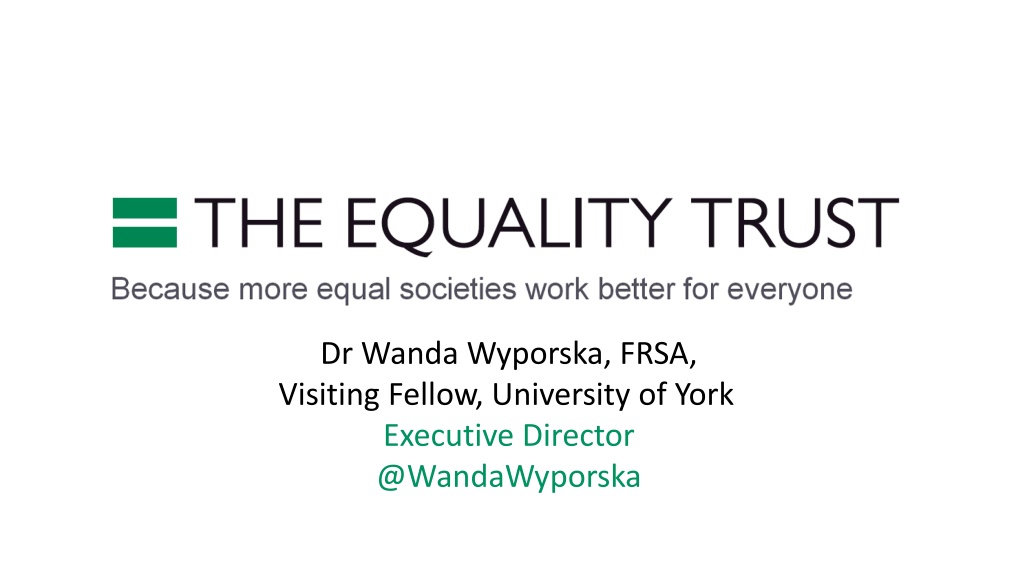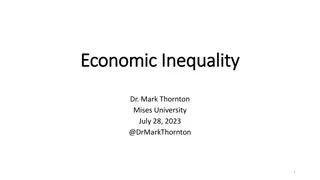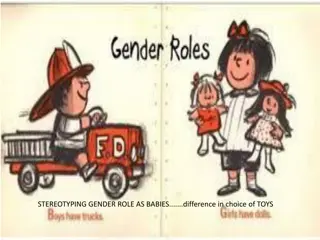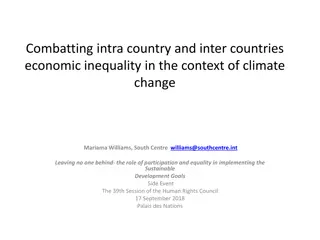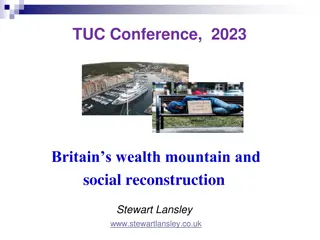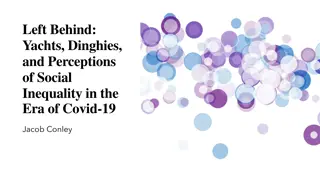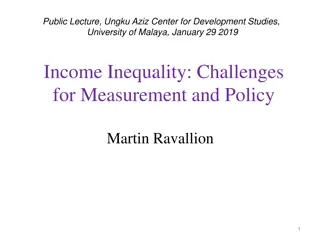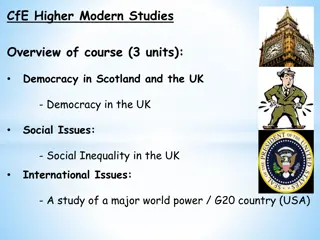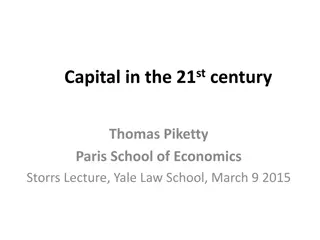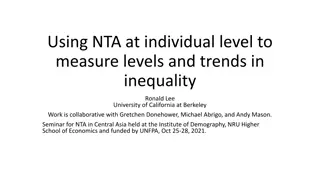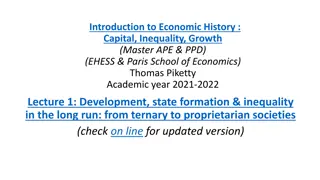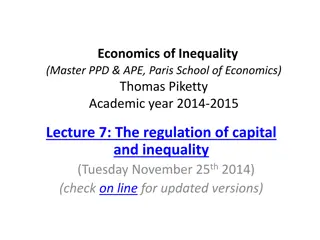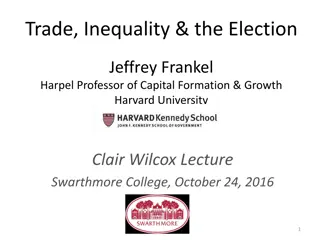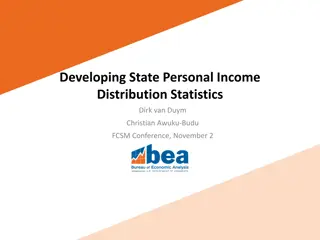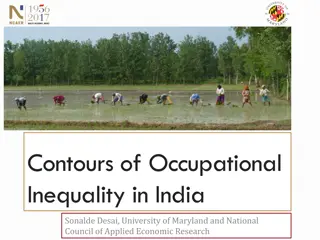The Impact of Inequality on Society
the consequences of wide wealth gaps, high CEO wages, and the threat of inequality on social relationships and economic growth. Learn how inequality influences behaviors and creates divisions in society, affecting individuals and communities.
Download Presentation

Please find below an Image/Link to download the presentation.
The content on the website is provided AS IS for your information and personal use only. It may not be sold, licensed, or shared on other websites without obtaining consent from the author. Download presentation by click this link. If you encounter any issues during the download, it is possible that the publisher has removed the file from their server.
E N D
Presentation Transcript
Dr Wanda Wyporska, FRSA, Visiting Fellow, University of York Executive Director @WandaWyporska
Pay Tracker Pay Tracker CEOs in the UK s top 100 companies now pocket an average of 5.3m* each year, or 386 times that of a worker earning the National Living Wage. Over two thirds (67%) of FTSE 100 CEOs are paid more than 100 times the average UK salary. Ninety per cent of FTSE 100 CEOs are paid at least 100 times more than the National Living Wage. Equality Trust analysis also found that FTSE 100 CEOs are now paid: 165 times more than a nurse. 140 times more than a teacher. 132 times more than a police officer. 312 times more than a care worker.
Wealth Tracker Wealth Tracker Richest 1,000 people own more wealth than 40% of households, or 10.2 million families. From 2013 the combined wealth of Britain s 1,000 richest people increased by 274 billion to 724 billion.
Inequality as a threat Inequality as a threat IMF Lower net inequality is robustly correlated with faster and more durable growth." OECD Policies to reduce income inequalities should not only be pursued to improve social outcomes but also to sustain long-term growth." CBI Research from the IMF shows that nations with higher inequality tend to enjoy shorter periods of growth, and also tend to grow more slowly.
What does this look like? What does this look like? Inequality encourages us to see each other as potential threats and we are therefore more likely to adopt dominance strategies (competition, bullying, violence). Greater equality encourages us to see each other as potential allies and we are therefore more likely to adopt affiliative strategies (co-operation, helping, kindness). Inequality encourages us to bow down before power and kick down on those less powerful in order to shore up our own social status. In monkeys this observed behaviour has been termed the Bicycling Reaction .
Life expectancy and infant mortality Life expectancy and infant mortality Last year we raised concern about the rise in infant mortality in England and Wales in a letter to the BMJ.(1) The latest data released by the ONS this week shows that infant mortality has risen for the second year running. In 2016 there were 2651 infant deaths, compared to 2578 and 2517 in the preceding two years. David Robinson et al. The LSP s analysis shows that, of the many factors comprising the Index of Multiple Deprivation, income levels have the most powerful influence over neighbourhood death rates. From Blackpool to Belgravia Longevity Science Panel February 2018
Discrimination protected characteristics The Equality Act 2010 Age Disability Ethnicity and race Sex Gender reassignment Religion and belief Sexual orientation Marriage and civil partnership Pregnancy and maternity
Disability Disability 3.5 million disabled people of working age in the UK. 49.2% of disabled people were in employment v 80.6% of non-disabled people. 9% unemployment rate for disabled people v 3.8% of non-disabled people
Gender Gender not just pay gaps and equal pay not just pay gaps and equal pay A study of science faculties in higher education institutions (Moss-Racusin et al 2012) asked staff to review a number of applications. The applications reviewed were identical, apart from the gender of the name of the applicant. Science faculties were more likely to: rate male candidates as better qualified than female candidates want to hire the male candidates rather than the female candidates give the male candidate a higher starting salary than the female candidate be willing to invest more in the development of the male candidate than the female candidate (ECU)
Runnymede Trust and Womens Budget Group Runnymede Trust and Women s Budget Group 2016 report: The analysis shows that by 2020: Individuals in the poorest households lose most from tax and benefit changes, but in every income group BME women will lose the greatest proportion of their individual income. Low income black and Asian women will lose around twice as much money as low income white men as a result of tax and benefit changes. Out of all household types, lone mothers are hardest hit by cuts to services and tax and benefits changes followed by lone fathers and single female pensioners (see Figure 2). Among lone mothers, it is again BME women that lose the most. Nearly half of ethnic minority children live in poverty. Ethnic minority pay gap of 37% in the capital s public sector.
Class pay gap Class pay gap A Social Mobility Commission report found that Britain s traditional professions such as medicine, law, journalism and academia remain dominated by those from advantaged backgrounds - nearly three quarters (73%) of doctors are from professional and managerial backgrounds with less than 6% from working class backgrounds. The average class pay gap is 6,800.
Socio Socio- -Economic Duty (Section 1), Economic Duty (Section 1), The Equality Act, 2010 The Equality Act, 2010 when making decisions of a strategic nature about how to exercise its functions to have due regard to the desirability of exercising them in a way that is designed to reduce the inequalities of outcome which result from socio-economic disadvantage .
www.equalitytrust.org.uk @equalitytrust Wanda.Wyporska@equalitytrust.org.uk
